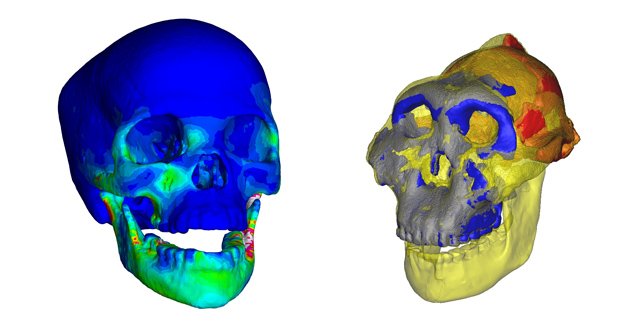Human bite stronger than apes’

MODERN HUMANS CAN BITE off more than apes can chew, according to new research.
Australian scientists have found that the relatively light human skull has a far more efficient bite compared to the jaws of chimpanzees, gorillas, and orangutans.
Through the use of sophisticated three-dimensional (3D) computer modelling, Dr Stephen Wroe and colleagues from the University of New South Wales and University of Newcastle found that humans have remarkably efficient jaws, capable of producing relatively powerful bites.
The research also showed that early humans, the prehistoric Australopithecus africanus and Paranthropus boisei had weaker bites than modern humans, shedding light on the evolution of our feeding behaviour.
“As it turns out, modern humans don’t have a wimpish bite at all,” Stephen says. “It is very efficient and powerful for an ape of our size. Pound for pound, even without advances in technology, humans, with their tiny little jaws and jaw muscles, are still quite capable of processing some quite hard foods just as well as any other ape species.”
All the better for eating with
To determine which species of hominid has the strongest bite force, the scientists reconstructed and compared the skulls of early humans, modern humans and apes.
The team used a technique approach known as 3D finite element analysis to compare digital models of actual skulls that had been CAT-scanned. The technique, adapted from engineering, provides a highly detailed view of where stresses occur in materials under forces determined by the researcher.
It was previously suggested that human jaw muscles were weakened to make way for an increase in brain size – resulting in behaviour changes like switching to softer foods or developing food processing technologies.
However, the new research, which was published online last week in the journal, Proceedings of the Royal Society B, implies that early humans did not need technology to eat high-nutrient hard foods such as nuts and tough meat.
The researchers found that when compared to living apes, modern human teeth are well adapted to take high loads as they have large roots and thick enamel. This gives humans the ability to quickly crack open a hard nut – but the trade off is a reduced ability to sustain chewing through tough, low quality materials such as leaves or bamboo.
According to co-author Dr Colin McHenry from the University of Newcastle, the research not only found that humans don’t need robust muscles to generate high bite forces, but pieces together some of the mysteries of human evolution.
“One interesting thing about the study is it actually does explain little bits of data that didn’t make sense before,” Colin says. “I think what this study is leading to is more research into how, from a biomechanical perspective, humans evolved from the lineage we share with chimps and other apes.”
Professor of Bioanthropology at ANU Dr Colin Groves, who was not involved in the research, says there a many factors that influence the relationship between brain size, jaw structure and tooth size, so this study is just a piece of the evolutionary puzzle for humans.
“Natural selection is a very complicated process; there’s a lot of material to act on, ” he says. “I think that they’ve shone light on a process which was insecurely known before. Further research into fossils and measurements into bite force could help. Also tests on different people should be very useful.”
Stephen’s team have previously used this approach to study the jaw
mechanics of living and extinct species as varied as the great white
shark and the sabre-toothed tiger.

